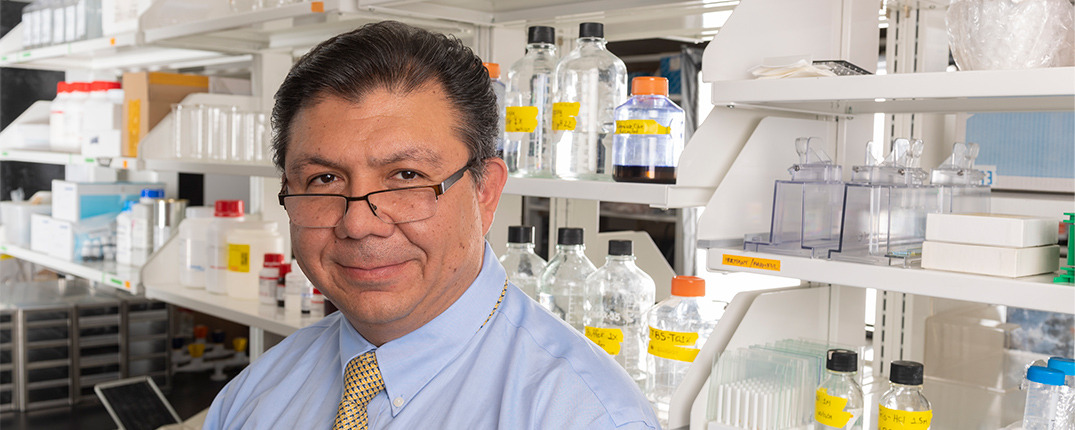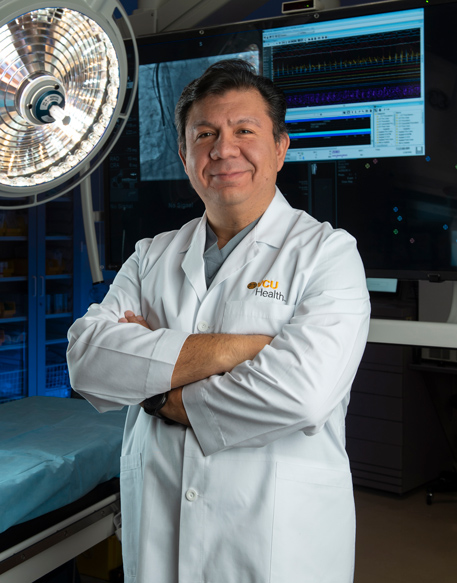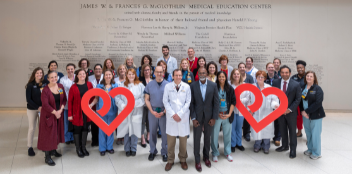The $2 million man
Research into extra heartbeats resonates with grant-making agencies

Early in his career, Dr. Jose Huizar became increasingly intrigued by extra heartbeats in his cardiac patients.
It was the mid-2000s, and Huizar was providing clinical care to veterans at Hunter Holmes McGuire VA Medical Center, where he is co-affiliated with Pauley Heart Center. At the time, the medical literature was divided on the phenomenon of extra heartbeats, which present as a fluttering or flip-flop feeling in the chest. Some researchers suggested that these extra beats, called premature ventricular contractions, or PVCs, weaken the heart. Others argued that, no, a weak heart causes the extra beats.
The common treatments to eradicate PVCs were medication or ablation — treatments that Huizar and his colleagues routinely provided. But Huizar, who’d become keenly interested in electrophysiological unknowns since completing his post-residency fellowship, was compelled to ask: Were these actions medically necessary? Did the PVCs, in fact, weaken the heart?
The pursuit of answers set Huizar’s career on its current trajectory — and to date has resulted in more than $2 million in research grants.
Huizar, associate professor in the VCU Department of Internal of Medicine, Division of Cardiology, and director of the Arrhythmia and Device Clinic at McGuire, has devoted more than a decade to expanding his understanding and knowledge of the chronic effects of PVCs. He has done so while concurrently caring for patients in his field of cardiac electrophysiology. “I believe this gives me the advantage to better understand and try to answer critical clinical questions,” he explained.
Huizar’s highly successful record of attracting both public and private funding comes as no surprise to Pauley Heart Center Director Dr. Greg Hundley.
Last July, Huizar received a VA Merit Grant from the Department of Veterans Affairs to continue his work exploring the mechanisms behind a type of cardiomyopathy, or disease of the heart muscle, caused by PVCs. The grant builds on a three-year National Institutes of Health R01 grant he received that runs until April 2021. He is also principal investigator for a three-year R34 study, funded by the NIH, that runs until June 2020.
Huizar’s highly successful record of attracting both public and private funding comes as no surprise to Pauley Heart Center Director Dr. Greg Hundley. “[PVC-related cardiomyopathy] is a significant health problem,” he said. “Dr. Huizar brings innovation and a great plan to help solve the problem. He is a rapidly emerging, important investigator in the field.”
Understanding PVCs
Premature ventricular contractions are extra, abnormal heartbeats that begin in one of the heart’s two lower pumping chambers, called ventricles. They occur when ventricle contractions beat sooner than the next expected regular heartbeat, often interrupting the normal order of pumping. The extra beat is followed by a stronger heartbeat, which creates the feeling of a skipped beat or a flutter. These extra beats are usually less effective in pumping blood throughout the body.
PVCs can be triggered by heart disease or injury, which can interfere with the normal electrical impulses. Occasional extra beats are common, and usually no cause can be found. Often, they go away on their own. PVCs are diagnosed with an electrocardiogram test or by analyzing data from a Holter monitor, a portable device that captures heart rhythms over a period of time. Frequently, extra beats coexist in patients with cardiomyopathy, a condition characterized by heart failure and weak heart function. Cardiomyopathy impacts not only quality of life, but also the patient’s health and life expectancy.
“As a junior faculty, I realized the lack of understanding of the chronic effects of PVCs, and of how to identify patients at risk to develop PVC-induced cardiomyopathy,” Huizar said. “At that time, there were skeptics that believed that PVCs were the result of the cardiomyopathy. I took this as a challenge.”
Devising a way to reproduce PVCs for a preclinical study required original thinking and ingenuity. Huizar brought both to the task. He conceived the idea to reprogram a pacemaker to reproduce PVCs. Dr. Kenneth Ellenbogen, chair of VCU’s Division of Cardiology and director of clinical cardiac electrophysiology and pacing, supported the plan and connected him with a pacemaker company. “I thought it was a great idea and a very important line of research,” Ellenbogen said. “I encouraged him to pursue this method to create a clinically relevant model.”
Huizar developed a novel premature pacing algorithm that delivered extra beats on command, allowing him to reproduce chronic states of PVCs and study their lasting effects. “This will not only allow us to understand the mechanism associated with left-ventricular dysfunction and increased sudden cardiac death in patients with frequent PVCs, but, most importantly, will help us find targets to prevent and treat the effects of frequent PVCs,” he said.
From the three years of preclinical research that followed, Huizar proved that a normal heart exposed to “a lot” of extra beats induces a weak heart. In 2012 he was awarded a five-year American Heart Association Scientist Development Grant to study in detail how many extra beats were needed to debilitate the heart and cause heart failure.
In 2016, the American Heart Association published a scientific statement recognizing PVC-induced cardiomyopathy (PVC-CM) as a unique clinical entity — citing Huizar’s published research as establishing proof of concept. “It validated my work,” he said.
R34 and R01 studies
Huizar’s research into PVCs represents a major advance in the field of cardiac electrophysiology as we understand the mechanisms of disease progression and regression, Ellenbogen said.
 Huizar, with his unique expertise and interest, has helped make Pauley one of the select centers in the U.S. for PVCs research.
Huizar, with his unique expertise and interest, has helped make Pauley one of the select centers in the U.S. for PVCs research.
Two NIH grants — an R34 and an R01 — are enabling Huizar to further distinguish himself in the field and advance his understanding of PVCs on heart function. The studies made possible by these grants support the National Heart, Lung and Blood Institute’s mission of advancing translational research and are Huizar’s current research focus.
The R34 clinical pilot study is testing the hypothesis that the prevalence of PVC-CM is underestimated and that conducting a large, randomized clinical trial to test treatments is possible. Twenty thousand ambulatory ECG Holter monitors collected from health care centers around the country are being screened to identify patients with probable diagnosis of PVC-CM. Thirty-six patients with frequent PVCs and cardiomyopathy are being enrolled into the pilot study and randomized to receive either ablation or medication.
Generally, patients identified with PVC-CM are offered radiofrequency ablation, antiarrhythmic drugs or no treatment. “There is clear need for a large clinical trial comparing these strategies,” said Huizar, the study director working alongside co-investigators Ellenbogen, Dr. Adam Sima at VCU Medical Center, and Dr. Alex Tan and Dr. Karoly Kazsala at McGuire VA. “Yet, we need to better understand the prevalence of PVC-CM, and the feasibility and limitations of such a trial.”
VCU Medical Center and McGuire VA are two of the nine patient recruitment sites. All participants are receiving baseline cardiac imaging and are being observed for a three-month period before receiving treatment.
If successful, the R34 study will pave the way for a large, full-scale randomized trial to identify the best treatment strategy for patients with PVC-CM. “The pilot study is to get a sense of how many patients we can recruit and what are going to be the restrictions of recruiting,” Huizar explained.
Concurrent with the pilot study, Huizar and co-investigators Dr. Montserrat Samso, associate professor, and Drs. Jose Eltit and Rafael Ramirez, assistant professors in the Department of Physiology and Biophysics, are conducting an NIH R01 translational study to understand what changes PVCs cause on a molecular level that trigger weakening of the heart. The mechanism responsible for PVCs is unclear.
Some patients have a lot of PVCs but a normal heart, while other patients have a weak heart whose function improves when PVCs are eliminated. “It seems to me that there is some patient susceptibility that we don’t understand yet,” Huizar said. describing the study’s impetus.
He continued, “If you look at the patients that have PVCs versus those who don’t, they tend to have more heart failure in the long term. In general, sudden cardiac death is not that increased. But, if you look at the patients who have had sudden cardiac death versus no sudden cardiac death, those who have had sudden cardiac death have had more PVCs than the ones that haven’t. It indicates some risk.
“We think that there is some susceptibility, maybe genetic or in phenotype,” he added. “So, we’re trying not only to understand the weakening of the heart, but also mechanistically what PVCs have to do with the risk for arrhythmias and sudden death. Obviously, it gets very complicated when you go into a cellular level, and that’s why you need collaboration at a lot of different levels.”
A place for research
Under the direction of Ellenbogen, Pauley Heart Center has gained international recognition in the management of heart disease related to harmful heart rhythms. At Pauley’s electrophysiology clinic, patients with arrhythmias, including PVCs, are evaluated and treated by one of the most highly respected cardiac electrophysiology teams in the country. The team’s experience and expertise place the clinic among the top referral centers for evaluation and treatment of complex arrhythmias.
Huizar, with his unique expertise and interest, has helped make Pauley one of the select centers in the U.S. for PVCs research.
Pauley cardiologists are also leaders in research and part of an active cardiovascular disease research program that furthers knowledge of heart disease, its treatments and its cures. Huizar, with his unique expertise and interest, has helped make Pauley one of the select centers in the U.S. for PVCs research.
“Dr. Huizar is an important member of our cardiac electrophysiology team and an important contributing member to Pauley Heart Center,” Ellenbogen said. “He is focused, thoughtful, creative and persistent. That is what it takes to be successful at research and innovation. Equally important, he is surrounded by a team of collaborators that all work together.” Collaborators like cardiac electrophysiologists Tan and Kaszala, frequent co-investigators who add another layer of research to the knowledge and understanding of PVCs through their own work on the subject.
“VCU really nurtures people that want to do research. They support you here,” Huizar said. He cites colleagues Ellenbogen, Hundley, Dr. Clive Baumgarten and the late Dr. Mark Wood as mentors. “One of the reasons I’m at VCU is for research. I knew that there was no better place for me. There’s never a ‘no’ for an answer.”
Saying yes to research opens the door for bench-to-bedside innovations that benefit patients.
“We’re about the discovery of new ways to reduce heart disease,” Hundley reminded. “Dr. Huizar is researching a frequently encountered problem of palpitations, which his research shows reduce heart performance. Solving this will improve our patients’ well-being.”
Back to Spring-2020

